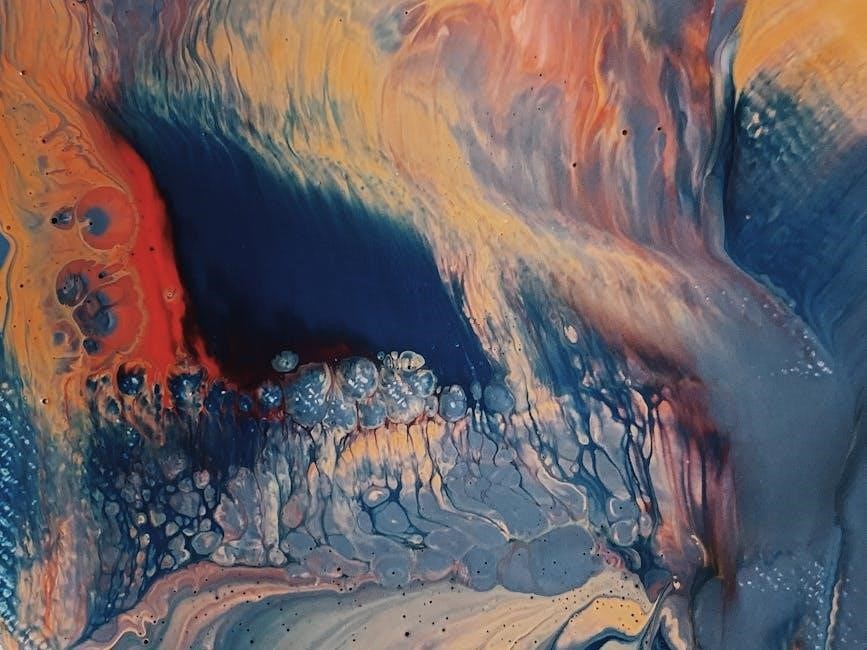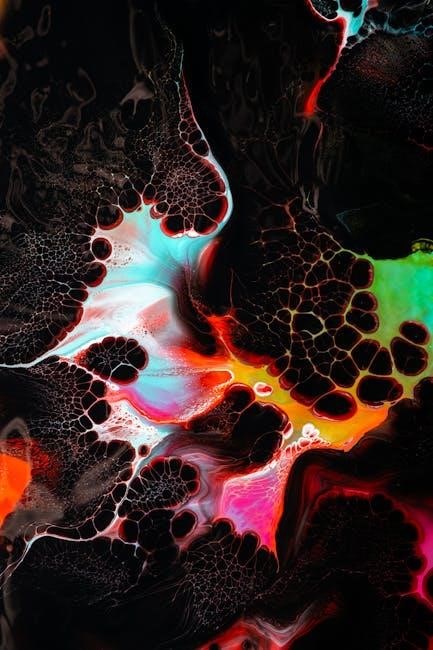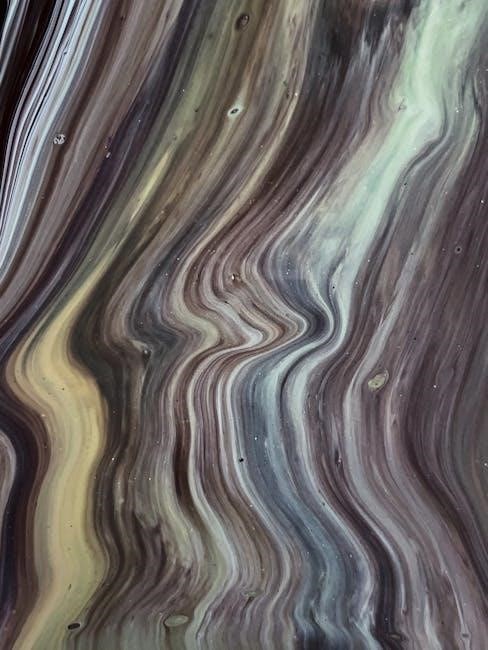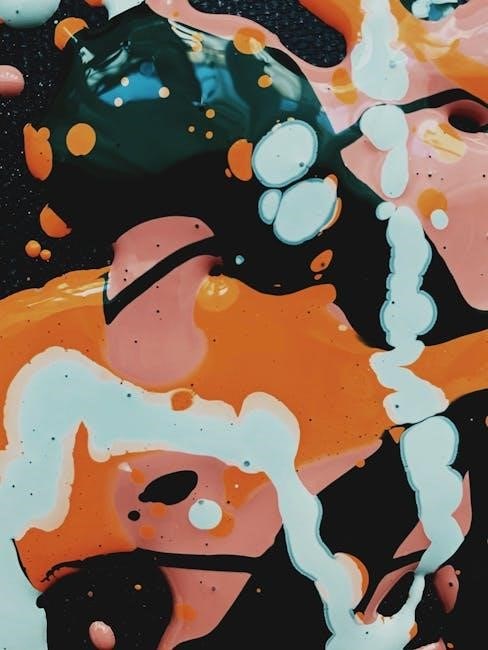Procion dyes are fiber-reactive dyes ideal for tie-dye, offering vibrant, permanent colors on natural fabrics through a cold-water process․ They are known for their intense hues and durability․
1․1․ What Are Procion Dyes?
Procion dyes are fiber-reactive dyes that form permanent, vibrant bonds with natural fabrics like cotton, linen, and rayon․ They are activated in cold water and require soda ash to fix colors, ensuring durability and colorfastness․ These dyes are popular for tie-dye and immersion dyeing due to their intense hues and versatility, making them a favorite among crafters and professionals for achieving bold, long-lasting designs․
1․2․ Benefits of Using Procion Dyes for Tie-Dye
Procion dyes offer vibrant, permanent colors and excellent colorfastness, making them ideal for tie-dye․ They bind directly to fabric fibers, ensuring durability and minimal fading․ Their cold-water activation simplifies the process, and they work beautifully on natural fabrics like cotton and linen․ The wide range of colors and ability to mix custom shades provide endless creative possibilities for unique, professional-quality tie-dye designs․
Materials and Equipment Needed
Essential materials include soda ash, rubber gloves, squeeze bottles, measuring spoons, dye powders, and plastic buckets․ Protective gear like gloves and goggles ensure safe handling of chemicals․
2․1․ Essential Supplies for Procion Dyeing
The essential supplies include soda ash for pre-treating fabric, rubber gloves for protection, squeeze bottles for dye application, and measuring spoons for accurate dye measurement․ Additional items like plastic buckets, protective eyewear, and urea (optional for enhancing color) are also necessary․ Drop cloths or plastic sheets can protect work surfaces from stains․ These supplies ensure a safe and effective dyeing process․
2․2․ Protective Gear and Safety Precautions
Wear rubber gloves to prevent skin contact with dyes and soda ash․ Use a face mask when handling dye powders to avoid inhalation․ Protective eyewear is recommended to safeguard against accidental splashes․ Ensure good ventilation to prevent inhaling fumes․ Avoid eating or drinking while dyeing․ Keep the workspace clean and out of reach of children․ These precautions ensure a safe and controlled dyeing environment․
Preparing the Fabric
Pre-wash fabric to remove finishes and impurities․ Soak in a soda ash solution (1 cup per gallon of water) for 20 minutes to enhance dye absorption and bonding․
3․1․ Pre-Washing the Fabric
Pre-washing fabric in hot water with a detergent like Dharma’s Professional Dyeing Detergent removes oils, dirt, and finishes that might resist dye․ This step ensures even color absorption and prevents uneven results․ Use hot water to open fabric fibers fully․ Do not dry the fabric completely; it should be damp but not soaking wet before folding or tying for the dyeing process․
3․2․ Soda Ash Soak for Fabric Preparation
Soak fabric in a mixture of 1 cup soda ash per gallon of water for 20 minutes․ Ensure soda ash is fully dissolved for optimal results․ Gently squeeze out excess water without wringing, leaving the fabric damp but not dripping․ This step activates fibers, enabling Procion dyes to bond effectively, ensuring vibrant and long-lasting colors․
Mixing the Dye
Measure Procion dye powder according to color intensity: 2-8 teaspoons per 8 oz of warm water․ Mix thoroughly to dissolve․ Add urea for better color retention․ Solution is best used fresh but can last up to two days for optimal vibrancy․
4․1․ Measuring Procion Dye Powder
Procion dye powder is measured by teaspoons based on desired color intensity․ Colors with no asterisks require 2 teaspoons, one asterisk needs 4, and two asterisks need 8 teaspoons per 8 oz of warm water․ Use a digital scale for precise measurements․ Ensure the powder is fully dissolved in water before application for consistent results․
4․2․ Creating the Dye Solution
To create the dye solution, mix the measured Procion dye powder with 8 oz of warm water․ Add urea to enhance color saturation and prevent drying out․ Stir thoroughly until the powder dissolves․ Transfer the solution to squeeze bottles for precise application․ The dye solution is most vibrant when used within the first four hours but remains effective for up to two days․
Tie-Dye Folding and Binding Techniques
Tie-dye folding involves creating patterns by folding fabric into shapes like spirals or accordion pleats․ Binding with rubber bands ensures the dye penetrates selectively, achieving unique designs․
5․1․ Basic Folding Methods for Tie-Dye
Basic tie-dye folding includes methods like the bullseye fold, stripe fold, and scrunch technique․ The bullseye involves folding fabric into concentric circles for a target-like pattern․ The stripe fold creates straight lines by folding the fabric into accordion pleats․ The scrunch method involves gathering fabric randomly for a more organic look․ Securing folds with rubber bands ensures the dye penetrates evenly, resulting in distinct, vibrant designs․
5․2․ Advanced Binding Techniques
Advanced binding techniques include accordion folding, spiral twisting, and layering folds․ Accordion folding involves pleating fabric and binding with rubber bands for sharp, linear patterns․ Spiral twisting creates dynamic, circular designs by twisting and securing fabric․ Layering folds combines multiple techniques for intricate results․ These methods require precision but yield unique, complex patterns․ Use additional bindings to experiment with layered color effects and ensure vibrant outcomes․

Applying the Dye
Apply Procion dyes using squeeze bottles or brushes for direct application, or try ice dyeing for unique, blended effects․ Both techniques ensure vibrant colors and creative results․
6․1․ Direct Application of Procion Dyes
Direct application involves mixing Procion dye powder with water to create a solution, then applying it to the fabric using squeeze bottles, brushes, or sponges․ This method allows precise control over color placement and pattern creation․ Ensure the fabric is pre-treated with soda ash for optimal dye absorption․ The dye solution is typically mixed at a ratio of 2-4 teaspoons per cup of water, depending on the desired intensity․ This technique is ideal for achieving vibrant, detailed designs and is often used in tie-dye and hand-painting methods․ Always wear protective gloves to avoid skin staining․
6․2․ Ice Dyeing Method
The ice dyeing method involves placing crushed ice on folded, pre-treated fabric․ Procion dye powder is sprinkled over the ice, and as it melts, the dye creates unique, organic patterns․ This technique produces soft, watercolor-like effects and vibrant color blending․ Allow the ice to melt completely before rinsing; The process is ideal for achieving unpredictable, geode-inspired designs on fabric, making each piece truly one-of-a-kind․

Dyeing Process
Submerge the tied fabric in the dye bath, ensuring even coverage․ Allow it to soak for 10-30 minutes, occasionally agitating gently for uniform color distribution․ Keep fabric wrapped tightly during the process to prevent unfolding․ The longer it soaks, the deeper the colors will set into the fabric․
7․1․ Immersion Dyeing
Immersion dyeing involves submerging the pre-treated fabric into a dye bath․ Ensure the fabric is fully covered by the dye solution․ Gently agitate the fabric periodically to achieve even color distribution․ For pastel shades, soak for 15 minutes, while deeper colors require up to 30 minutes․ Avoid excessive movement to prevent fabric from unfolding and ruining the pattern․
7․2․ Allowing the Dye to Set
After immersion or direct application, allow the dye to set for 15–30 minutes, depending on desired intensity․ Keep the fabric folded or tied to maintain patterns․ Avoid movement to prevent color bleeding․ This step ensures the dye fully bonds with fibers, resulting in vibrant, long-lasting colors․ The fabric should remain undisturbed during this time to achieve optimal color saturation and pattern retention․
Rinsing and Washing
Rinse the fabric under cold running water until the water runs clear to remove excess dye․ Wash separately in cold water with mild detergent to prevent color bleeding․
8․1․ Rinsing the Fabric After Dyeing
After allowing the dye to set, rinse the fabric under cold running water while it’s still tied to remove excess dye․ Gently massage the fabric to ensure thorough rinsing․ Continue rinsing until the water runs clear, which stops the dye reaction and prevents color bleeding․ Avoid using hot water, as it may cause colors to fade or bleed excessively․ This step is crucial for achieving vibrant, long-lasting results․
8․2․ Washing the Dyed Fabric
After rinsing, wash the dyed fabric in cold water using a mild detergent․ Avoid using bleach or hot water, as this can damage the colors․ Gently agitate the fabric to remove any remaining dye residue․ Do not soak the fabric for extended periods, as this may cause color bleeding․ Wash separately from other clothes for the first few cycles to ensure colorfastness and protect other garments from potential dye transfer․

Troubleshooting Common Issues
Address uneven colors by adjusting dye quantities or soaking times․ Prevent bleeding by using soda ash fixative and cold water․ Ensure proper fabric preparation and dye saturation․
9․1․ Fixing Uneven Color Distribution
Uneven color distribution can occur due to insufficient dye or poor fabric absorption․ To fix this, increase dye quantity or extend soaking time․ Ensure even application and proper folding techniques․ Soda ash pretreatment helps bind colors effectively․ Gently agitate fabric during dyeing to promote uniform saturation․ Thorough rinsing after dyeing prevents residual dye from causing unevenness․ Adjusting these steps ensures vibrant, consistent results․
9․2․ Preventing Color Bleeding
Prevent color bleeding by ensuring proper dye fixation․ Use soda ash to bind colors to fabric, promoting durability․ After dyeing, rinse thoroughly with cold water to remove excess dye․ Wash dyed fabrics separately using mild detergent to prevent color transfer․ Allowing the dye to set fully before washing is essential․ Following these steps helps maintain vibrant, long-lasting colors and prevents bleeding․

Caring for Procion-Dyed Fabrics
Wash Procion-dyed fabrics in cold water with a mild detergent to prevent color bleeding․ Air-dry to maintain vibrancy and prevent fading․ Avoid using fabric softeners or harsh chemicals․
10․1․ Washing Instructions for Dyed Fabrics
Wash Procion-dyed fabrics in cold water using a mild detergent to prevent color bleeding․ Turn garments inside out to protect the dye․ Avoid using bleach or fabric softeners, as they can fade colors․ Air-dry instead of machine-drying to preserve vibrancy․ For hand-washing, gently agitate and rinse thoroughly․ Separate dyed fabrics from others to prevent cross-staining․ This ensures long-lasting, vibrant results․
10․2․ Maintaining Color Vibrancy
To maintain the vibrancy of Procion-dyed fabrics, wash them in cold water with mild detergents free of bleach or softeners․ Avoid direct sunlight exposure, as it can fade colors over time․ Air-drying is recommended, as heat from dryers can dull hues․ Store dyed fabrics separately to prevent color transfer․ Regularly cleaning and storing properly ensures colors remain vivid for years․
Environmental and Safety Considerations
Use eco-friendly practices, dispose of dye waste safely, and avoid harmful chemicals․ Wear protective gear and follow instructions to minimize environmental impact and ensure safe dyeing processes․
11․1․ Eco-Friendly Practices for Dyeing
Eco-friendly dyeing involves using natural fibers, minimizing water waste, and employing non-toxic soda ash․ Dispose of leftover dye responsibly and avoid harmful chemicals․ Opt for sustainable practices, such as using Procion dyes, which are known for low environmental impact․ Always follow safety guidelines and consider eco-conscious methods to reduce your carbon footprint during the dyeing process․
11․2․ Disposing of Dye Waste Safely
Mastering Procion dyes opens up a world of creativity, ensuring professional results․ Explore official guides and creative communities for endless inspiration and advanced techniques․
12․1․ Final Tips for Successful Procion Dyeing
- Always pre-wash fabrics to remove impurities for better dye absorption․
- Use accurate measurements for dye and soda ash to ensure vibrant results․
- Allow the dye to set for the recommended time to achieve optimal colorfastness․
- Rinse thoroughly before washing to prevent color bleeding․
- Wash dyed fabrics separately in cold water to maintain color vibrancy․
12․2․ Recommended Resources for Further Learning
For deeper exploration, explore books like “The Art of Natural Dyeing” and “Tie-Dye: The Ultimate Guide․” Visit websites like Dharma Trading Co․ and Pro Chemical & Dye for detailed guides․ YouTube channels such as Tie-Dye Mastery offer step-by-step tutorials․ Join online forums like Craftster for community tips and inspiration to enhance your Procion dyeing skills and creativity․